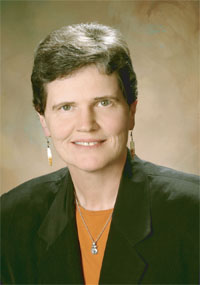Feds support new national LGBT youth suicide prevention task force
A national task force dedicated to suicide prevention among LGBT youth will be part of the new National Action Alliance for Suicide Prevention. The Alliance, launched by Secretary of Health Kathleen Sebelius and Secretary of Defense Robert Gates in September, is a public-private partnership supported by the U.S. Department of Health and Human Services’ Substance Abuse and Mental Health Services Administration (SAMHSA).
Pamela S. Hyde, administrator of SAMHSA, revealed the plan for an LGBT youth task force in a five-page letter sent November 5 in response to an inquiry from leaders of the U.S. House’s LGBT Equality Caucus.
The task force will be led by Charles Robbins, head of The Trevor Project, which operates an LGBT youth suicide prevention program nationwide, and Kevin Jennings, the Department of Education’s Assistant Deputy Secretary for the Office of Safe and Drug-Free Schools. Jennings, an openly gay appointee, founded the Gay, Lesbian, and Straight Education Network (GLSEN).
Robbins said in an interview that he thinks the Alliance could have a “broad impact” and “provide greater awareness and greater funding opportunities specifically for the LGBT community.” He said he participated in a similar effort in California and was able to ensure that LGBT youth were included in the plans and that county grants were LGBT inclusive.
The Alliance will, however, act as a coordinating body and not have independent grant-making authority, said Dr. Richard McKeon, Suicide Prevention Branch Chief at SAMHSA, in an interview October 19.
Hyde’s letter was in response to an October 26 letter from U.S. Reps. Jerrold Nadler (D-NY), Barney Frank (D-MA), Tammy Baldwin (D-WI), and Jared Polis (D-CO). They had written to Hyde to urge the agency to take “immediate action… to better protect LGBT youth and prevent further tragedies.” Their letter also questioned SAMHSA’s recent draft plan, Leading Change, and asked whether the agency is putting enough emphasis on “specific suicide prevention efforts” aimed at LGBT youth. They asked to be informed of SAMHSA’s current and planned activities in this regard.
In her response, Hyde, another of President Obama’s openly LGBT appointees, said SAMHSA “recognizes that LGBT youth face unique risk factors that make them vulnerable to suicide” and that the agency “will use its programs and initiatives to ensure a focus on LGBT youth.”
Specific SAMHSA efforts for helping LGBT youth, Hyde wrote, include the SAMHSA-funded Suicide Prevention Resource Center, which “includes LGBT youth as one of its priority populations.” The agency has also “produced publications and trainings geared toward improving awareness and capacity for suicide prevention for LGBT youth.”
SAMHSA’s National Suicide Prevention Lifeline, Hyde noted, “routinely refers youth to The Trevor Project.” The agency also directs funds to state, tribal, and campus suicide prevention programs through its Garrett Lee Smith grants, Hyde wrote, noting that currently nearly half of the 32 state grantees and nearly a third of the 68 campus grantees reported activities focused on LGBT youth.
Hyde said materials from the Human Rights Campaign’s Welcoming Schools program—designed to address family diversity, gender stereotyping, and bullying in elementary education—are included in resources given to grantees of SAMHSA’s Child, Adolescent, and Family Branch.
SAMHSA’s Annual Children’s Mental Health Conference this coming March will hold a workshop using the Welcoming Schools materials as well as anti-bullying resources developed by the Gay, Lesbian, and Straight Education Network (GLSEN). And a toolkit being developed by SAMHSA to help schools create suicide prevention programs will include materials from Trevor.
Additionally, Trevor will be invited to participate in SAMHSA’s National Workgroup on the behavioral health of LGBT youth and their families. The YES Institute, a Miami-based organization that trains providers, families, and others about suicide-related behavior in LGBT youth, is already taking part. The Workgroup, according to its Web site, will “help identify specific strategies and interventions” for caregivers and communities.
SAMHSA has also disseminated to staff and grantees recommendations from the Family Acceptance Project, a major academic study showing the connections between family rejection of LGBT youth and mental health problems, including depression and suicidal behavior.
Answering the representatives’ question about SAMHSA’s immediate next steps, Hyde wrote that she and leaders of the agency’s Sexual Gender Minority Interest Group recently met representatives of the National Coalition for LGBT Health, including Trevor, to plan ways of working together and including Trevor in some federal anti-bullying efforts.
To the representatives’ question about whether SAMHSA might need additional resources or legal authority to help with its efforts around LGBT youth, Hyde said no. She noted, however, that the attention on LGBT youth suicides has “mobilized SAMHSA staff and leadership across multiple Federal agencies to renew their commitment to these youth.”
Rep. Nadler, in a statement about Hyde’s reply, thanked SAMHSA for its “comprehensive response.” He called the agency’s “recommitment” and “increased focus” on suicide prevention among LGBT youth “encouraging.” He said he looked forward to seeing the “concrete steps” SAMHSA will take, and to working together with SAMHSA and other partners in the Obama Administration to ensure that they “achieve results.”



Leave a Reply